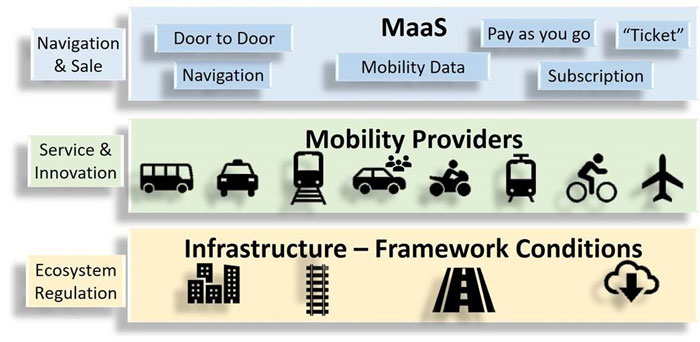Changing mobility with innovative new business models
- Like
- Digg
- Del
- Tumblr
- VKontakte
- Buffer
- Love This
- Odnoklassniki
- Meneame
- Blogger
- Amazon
- Yahoo Mail
- Gmail
- AOL
- Newsvine
- HackerNews
- Evernote
- MySpace
- Mail.ru
- Viadeo
- Line
- Comments
- Yummly
- SMS
- Viber
- Telegram
- Subscribe
- Skype
- Facebook Messenger
- Kakao
- LiveJournal
- Yammer
- Edgar
- Fintel
- Mix
- Instapaper
- Copy Link
Posted: 30 April 2018 | Luke Antoniou - Intelligent Transport, Søren Sørensen | No comments yet
Søren Sørensen, Nordic Representative of FAIRTIQ, spoke to Intelligent Transport’s Luke Antoniou to explain how innovation in ticketing technology is creating a new business model for mobility providers, why it could be bad news for hardware developers and how open services can help change the mobility landscape…


Everyone has heard the terms Mobility-as-a-Service and Software-as-a-Service – how about Ticketing-as-a-Service?
That is the term that perhaps best summarises what Swiss company FAIRTIQ is doing.
“We are the neutral third party that allows people to leapfrog into multi-modal account-based check-in/assisted check-out ticketing, without all the governance hassle that has previously prevented the public transport sector,” explains Søren Sørensen, FAIRTIQ’s Nordic Representative.
Mobile-based multi-modal ticketing is one thing but rolling it out across an entire nation is quite another, yet that is what the FAIRTIQ app has achieved in Switzerland. Switzerland is the perfect breeding ground for this type of technology and business model to really take off, as Sørensen explains: “Switzerland has one of the highest degree of public transport in Europe, so they are already leading from the front.”
It’s encouragement enough that expansion into other regions is already being trialled, with Germany and some Nordic countries proving themselves to be an ideal petri dish: “The Nordic countries are especially interesting as they have the highest penetration of smartphones, meaning it is a wonder-space for smart mobile ticketing.”
Easy access
Like many new mobility business models, this all stems from the idea that public transport companies and technology providers need to work together to remove as many barriers to public transport as possible.
“Currently you will experience that ticketing methods are unique for each city/region and are incompatible on a cross-region basis. For the customer, though, it’s far easier if they can travel in and across multiple regions with one method,” says Sørensen. “Once you on-board operators with this model, it grows from two regions to three and then four, and suddenly it’s across a whole country.”
Sounds simple enough, doesn’t it? But as with anything, it’s easy when you know how. Integration of this type of business model isn’t reliant only on the availability of technology, but also high-level penetration of public transport and accepting lessons from other regions and operators who both have and haven’t got it right. Shared experience is crucial to ensuring easy access to a city or – in this case – a country’s public transport network. According to Sørensen, an extensive, efficient network can only be gained via easy access: “Shared experience is definitely needed, but easy access is number one. You need to provide easy access to what you have; only then can you look to expand, and when you do, you have to expand smart,” he explains. “Importantly, I would say, you must take advantage of all the other mobility solutions that are available.”
Part of this easy access relies on ticketing. Indeed, Sørensen admits that ticketing is a nuisance but it needs to be in place, so it’s up to the industry to make it as small a nuisance as possible. It is a pain point that FAIRTIQ is looking to ease on a pan-European basis, for citizens and visitors alike. What stops a lot of people from using public transport, especially as a visitor in a new place, is how complicated the network appears. You need to learn about zones and tariffs and know a lot of things to ensure you get the right ticket. New technology can take the anxiety out of this situation and make ticketing and travel much simpler for travellers, even in countries and cities where the transport network is fragmented.
In this business model, only one relationship really needs to exist to make it work; between the operator and the ticket reseller, in this instance FAIRTIQ. The biggest challenge is to ensure the transport operator is happy for the third-party reseller to sell its tickets.
“From the customers’ point of view, it’s just buying a ticket – they shouldn’t have to do anything different whether catching bus A, B or C,” says Sørensen. “What counts for the transport provider is money; they need to be assured they will get their money from the ticket sale, and this model can offer them assurance that they will get it. It’s no different from buying a ticket from a local shop – except that the operator will receive their money much faster, directly into their account.”
This, then, doesn’t require a fundamental shift in the operator’s core business aim or focus – in fact, they can also continue selling tickets themselves, as they’re not handing over exclusivity or the right to sell tickets, they’re just extending the permissions of who can sell their tickets. Customer ownership and the ‘us and them’ mentality doesn’t need to, and shouldn’t, enter into the equation at all.
“It shouldn’t matter whether it is a transport operator selling a ticket directly or whether a company like FAIRTIQ sells the ticket. What matters is that the whole set up, the whole public transport grid, is supported.”
Trust: enabler and disruptor
The simplistic nature of this relationship makes it easy to see how rollout across Switzerland has been successful. Once trust between the operator and reseller is gained, there are no other hurdles to overcome; it is the one and only step.
With this kind of account-based ticketing, trust between the operator and third party also enables trust from the passenger. By linking their credit or debit card with the account to enable payment, the passenger is telling the reseller and the operator that they trust the service, and in turn will pay for the journey. A payment card linked to the account is effectively the best deposit and sign of trust you can gain as a transport and ticket provider.
Sørensen says that this kind of account-based ticketing can be likened to the Oyster card, except in this case, there is no need for a physical card to allow access at ticket gates. In fact, he says, there is no need for physical equipment like check-in readers either.
“On-board ticketing hardware, ticketing machines, the need to have money on your smartcard in advance of travelling – all those things are history with this type of technology,” explains Sørensen.
If a smartphone is truly all we need to travel, what happens to those manufacturers of ticketing hardware? How can they adapt to a new marketplace?
Sørensen says that it’s not so much a case of adaptation as it is a question of outright change: “Adapting would be like Kodak insisting on continuing with film in the modern day. All the check-in hardware, ticketing machines and back-office can now exist on a smartphone. Everything else has been put onto smartphones – look at how we consume music and film – so now is the time for public transport to join that revolution.”
Connectivity and openness
With the technology revolution already underway in the public transport sector, and with business models being developed to take advantage of those developments, city spaces are becoming broader and more heavily populated as accessibility improves. Achieving this requires a level of openness in data and in services that has previously been unattainable, but Sørensen thinks it’s the next major step in creating solutions that truly serve customers.


The shared mobility ecosystem
“In the traditional procurement cycle the best solutions at the time of implementation, the ones that best meet the procurement criteria, win, and the competition will have to develop over the next few years to try and win in the next cycle of new technology,” predicts Sørensen. “Being open would mean that having the competition going on every day in the market, only the best solutions survive. In an open environment, you can add new elements even daily, similar to how your mobile is always updating your apps, continuously informing you ‘now we also do this’.”
An increased openness in data and services will allow transport providers to focus more on their core business of moving people efficiently, says Sørensen, but there’s also a need to continue changing the attitudes of commuters to encourage a true modal shift to make privately owned cars a lesser part in the make-up of mobility. New and useful solutions to the first- and last-mile challenge will be crucial in affecting that change, as will demonstrating to people that car ownership isn’t the crux of mobility.
“I love driving a car, but the good thing is that I only use it as a service when a car is the best choice for my mobility requirements. Not being locked into car ownership actually gives me real freedom to choose the best modes of public and private mobility services, use my bike or even walk more. Hopefully this outlook can take hold across the public transport sector.”
That, ultimately, is the message that transport operators need to get across to their users, and with the help of new mobility services and new mobility business models, the sector is standing at the precipice of true, lasting change.
Biography


Related topics
Business Models, Passenger Experience, Ticketing & Payments
Related cities
Switzerland
Related organisations
FAIRTIQ
Related people
Søren Sørensen








